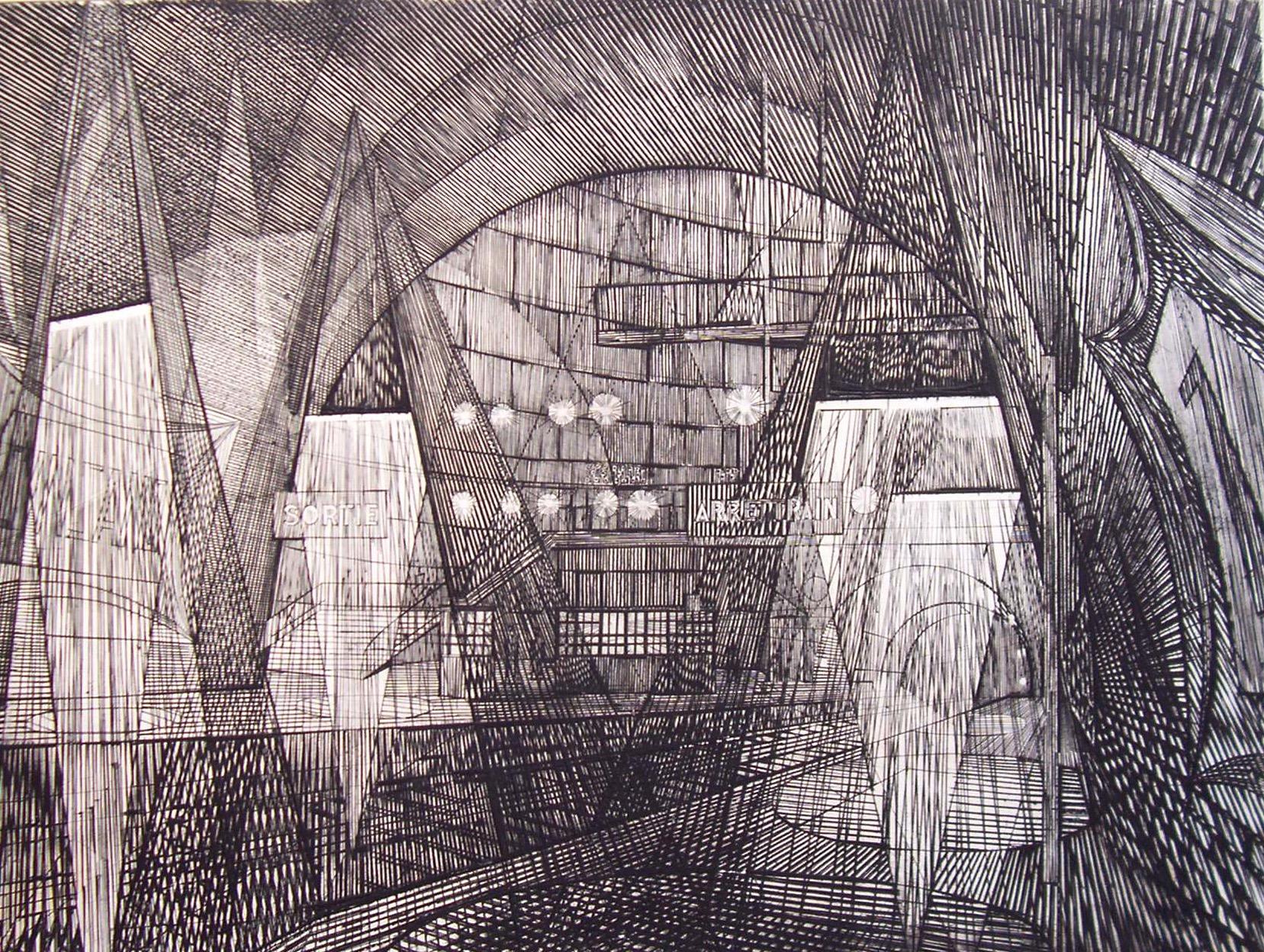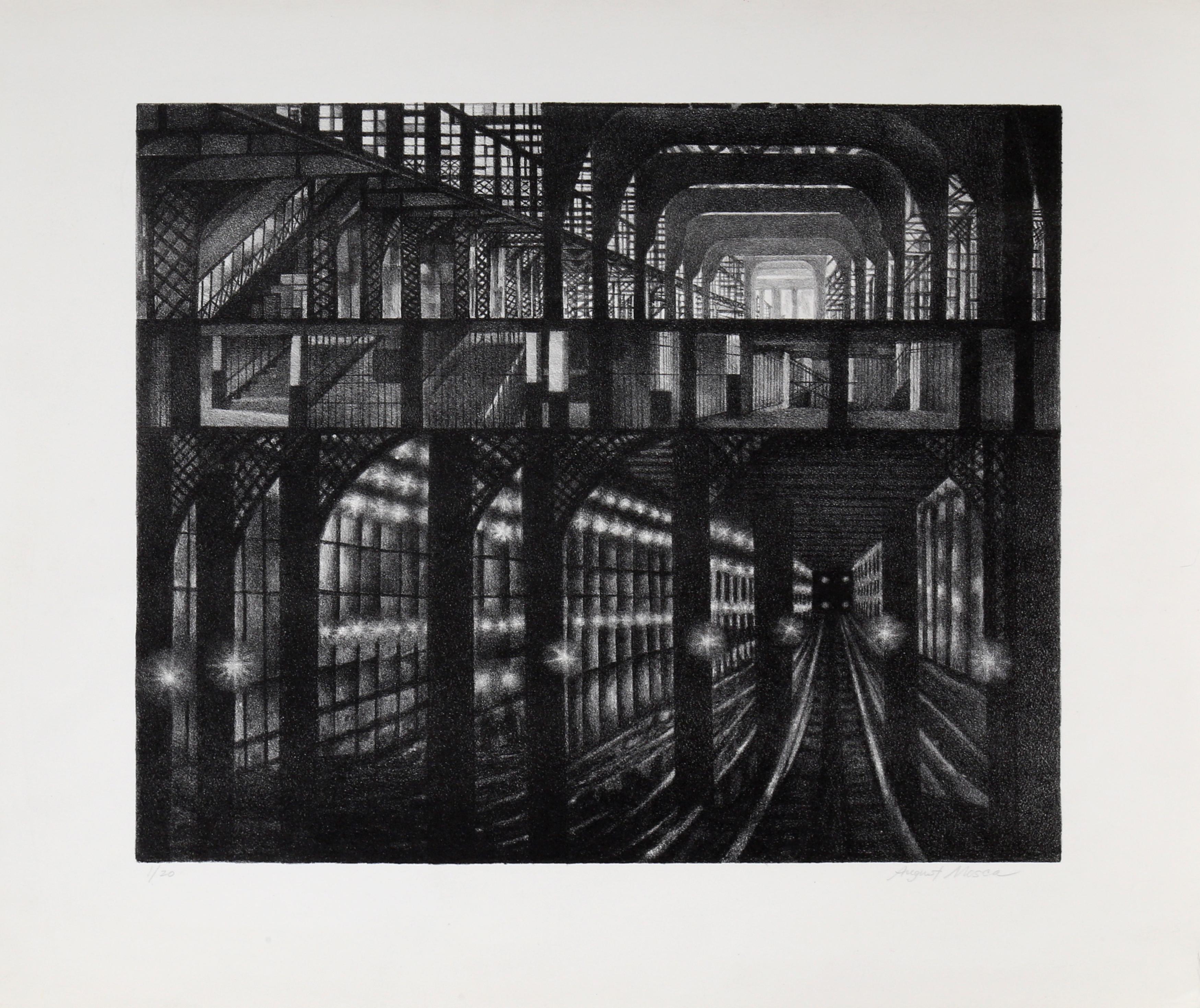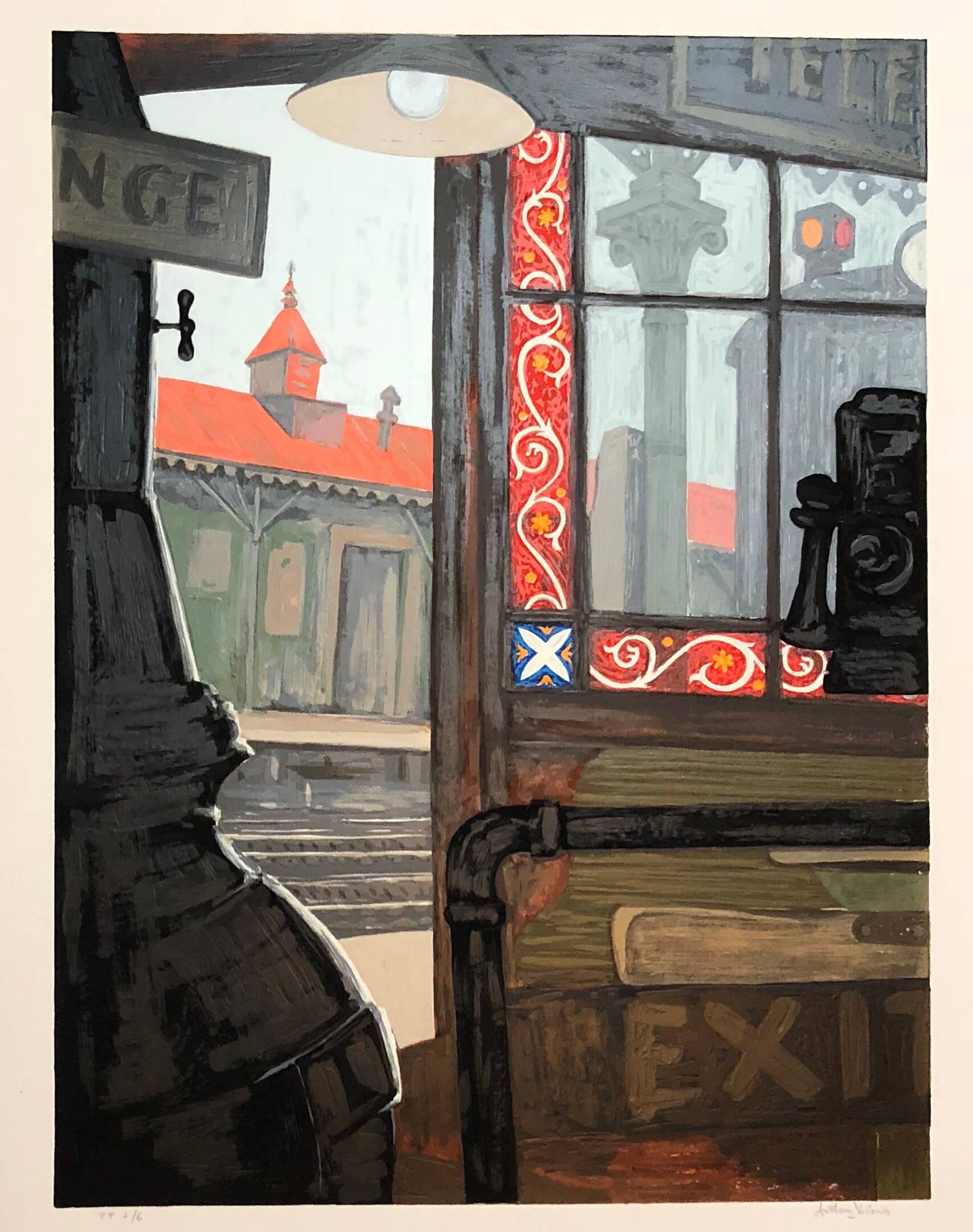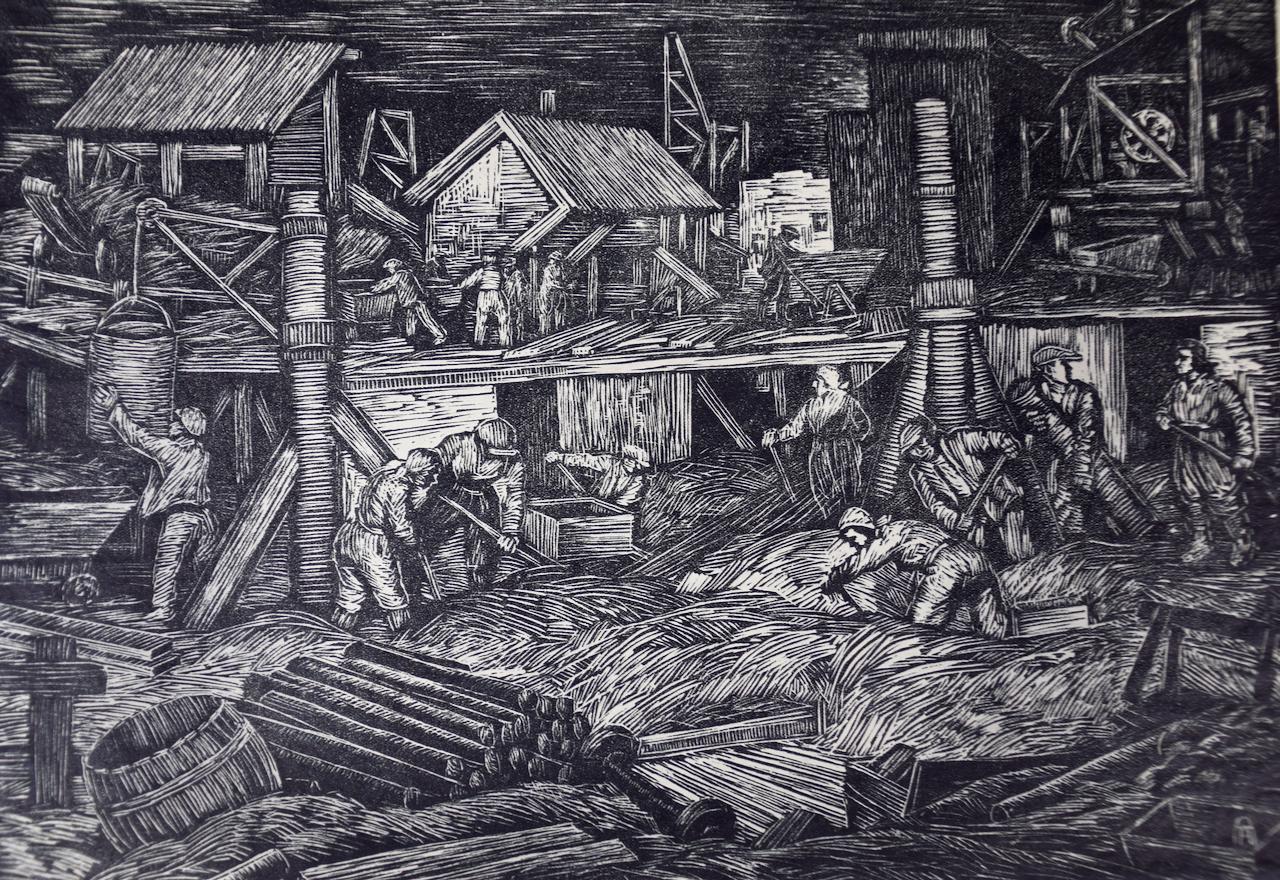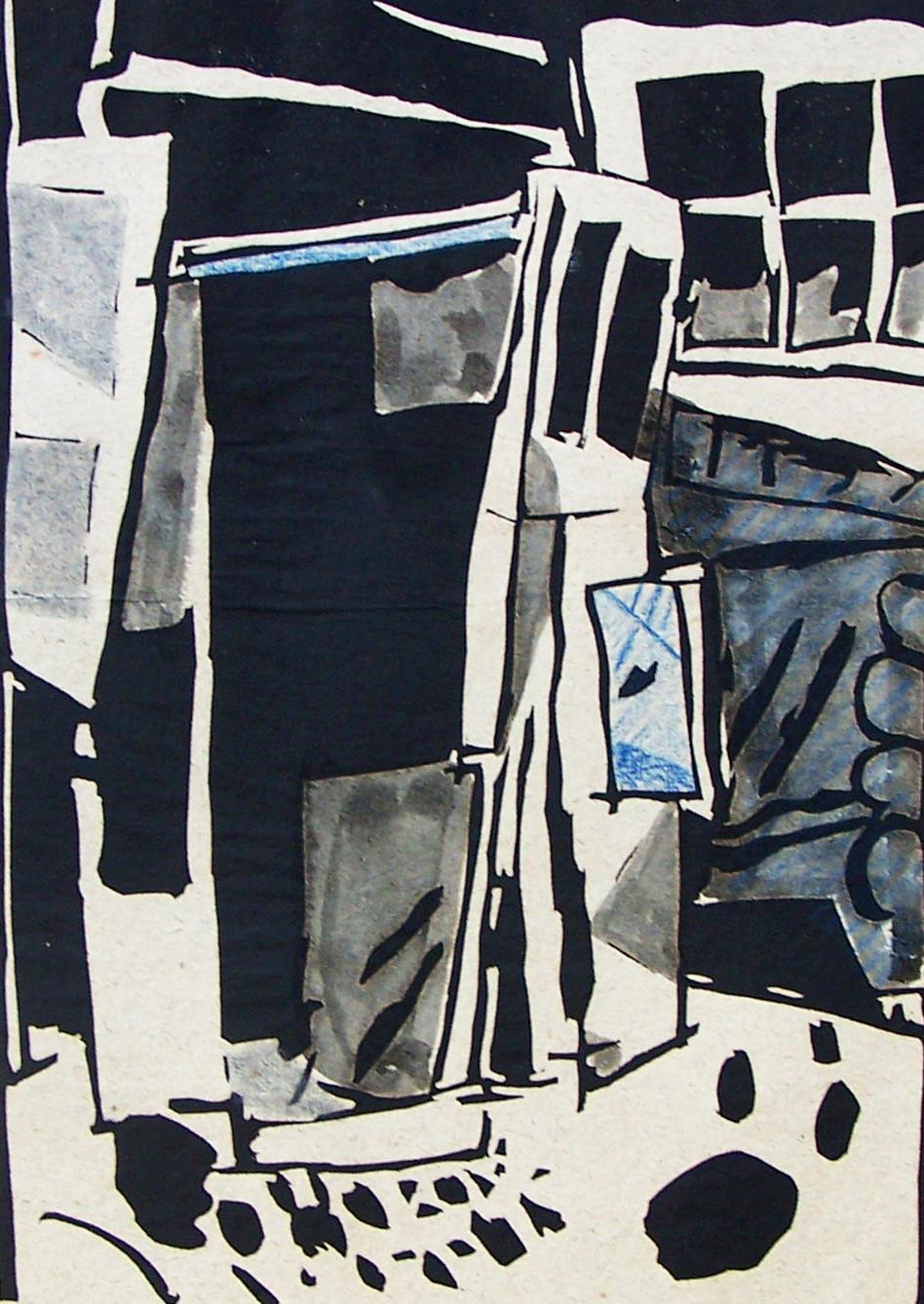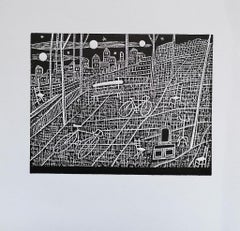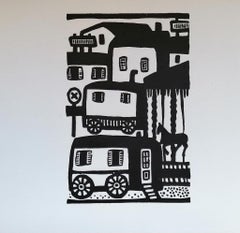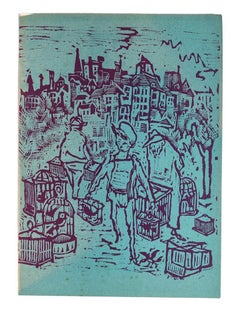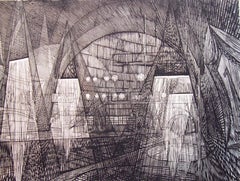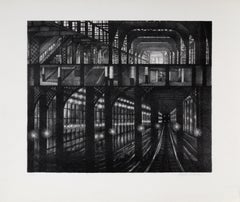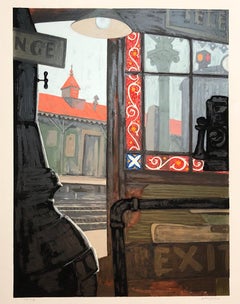Items Similar to The Metro Station in Paris - Original Woodcut by S. Birga - 1994
Want more images or videos?
Request additional images or videos from the seller
1 of 3
Sergio BirgaThe Metro Station in Paris - Original Woodcut by S. Birga - 19941994
1994
$298.56
£220.78
€250
CA$410.10
A$456.01
CHF 238.73
MX$5,570.27
NOK 2,999.88
SEK 2,821.99
DKK 1,903.56
About the Item
The Metro Station in Paris is an original contemporary artwork realized by Sergio Birga (Florence, 1940) in 1994.
Original B/W xylograph on ivory paper. Passepartout included (35 x 50 xm).
Hand-signed in pencil by the artist on the lower right corner: Birga. An original dedication is realized in pencil on the lower margin by the artist. Numbered on the lower left corner: 18/70. Signed and dated on plate on the lower left corner: SB 94.
Edition 18 of 70 prints.
Excellent conditions.
Beautiful contrasting xylograph depicting an urban scene in Paris; in the foreground there are some people walking and, on the left corner, a running train with small windows.
Sergio Birga (Florence, 1940). His first works are influenced by the German Expressionism. He moved to Germany to meet the protagonists of the movement: Heckel, Meidner, Kokoschka, Otto Dix and Conrad Felixmüller who gave him their advices and made an exchange of portraits with him. In 1965, he moved to Paris where he studied engraving at the Beaux-Arts in Lucien Coutaud's studio. From 1969 to 1975, he was a member of the Salon de la Jeune Peinture committee. In 1977, he participated in the exhibition “Mythologies Quotidiennes 2”. In the 1980s, he tackled new themes, linked to the Italian heritage of the classical painting, with references to gardens, statues, mythological figures
- Creator:Sergio Birga
- Creation Year:1994
- Dimensions:Height: 5.91 in (15 cm)Width: 8.67 in (22 cm)Depth: 0.08 in (2 mm)
- Medium:
- Movement & Style:
- Period:
- Framing:Framing Options Available
- Condition:Insurance may be requested by customers as additional service, contact us for more information.
- Gallery Location:Roma, IT
- Reference Number:Seller: M-1082271stDibs: LU65036610702
About the Seller
4.9
Platinum Seller
Premium sellers with a 4.7+ rating and 24-hour response times
1stDibs seller since 2017
7,681 sales on 1stDibs
Typical response time: 3 hours
- ShippingRetrieving quote...Shipping from: Grasse, France
- Return Policy
Authenticity Guarantee
In the unlikely event there’s an issue with an item’s authenticity, contact us within 1 year for a full refund. DetailsMoney-Back Guarantee
If your item is not as described, is damaged in transit, or does not arrive, contact us within 7 days for a full refund. Details24-Hour Cancellation
You have a 24-hour grace period in which to reconsider your purchase, with no questions asked.Vetted Professional Sellers
Our world-class sellers must adhere to strict standards for service and quality, maintaining the integrity of our listings.Price-Match Guarantee
If you find that a seller listed the same item for a lower price elsewhere, we’ll match it.Trusted Global Delivery
Our best-in-class carrier network provides specialized shipping options worldwide, including custom delivery.More From This Seller
View AllParis, Coffee Bar - Lithograph by Orfeo Tamburi - 1980s
By Orfeo Tamburi
Located in Roma, IT
Paris, coffee bar is a beautiful artwork realized by Orfeo Tamburi during the 1980s.
Mixed colored lithograph.
Edited and printed by Graphics Arte, Livorno...
Category
1980s Contemporary Landscape Prints
Materials
Screen
The Vallery of the Three Moons - Woodcut Print by Luigi Spacal - 1940s
Located in Roma, IT
The Vallery of the Three Moons is an original contemporary artwork realized by Luigi Spacal (Trieste, 1907 - Trieste, 2000) in the 1940s.
Original Black and White woodcut print on c...
Category
1940s Landscape Prints
Materials
Woodcut
Booths in the Province - Woodcut on Cardboard by Luigi Spacal - 1970s
Located in Roma, IT
Booths in the Province is an original contemporary artwork realized by Luigi Spacal (Trieste, 1907 - Trieste, 2000) in the 1970s.
Original B/W woodcut on cardboard.
Excellent cond...
Category
1970s Figurative Prints
Materials
Woodcut
Bird market - Original Woodcut by Mino Maccari - Mid-20th Century
By Mino Maccari
Located in Roma, IT
"Bird market" is an original woodcut print realized by Mino Maccari (1898-1989).
In good conditions.
This artwork represents men in the birds market while carrying birdcages in a w...
Category
Mid-20th Century Modern Figurative Prints
Materials
Woodcut
Café Parisien - Lithograph by Orfeo Tamburi - 1970s
By Orfeo Tamburi
Located in Roma, IT
Parisien Café is a Modern artwork realized by Orfeo Tamburi (Jesi, 1910 – Paris,1994) in the 1970s.
Colored Lithograph.
Hand-signed.
Numbered on the lower, Edition, 125 prints.
Good conditions.
Orfeo Tamburi (Jesi, Ancona,1910-Paris,1994) was an Italian painter and scenic designer.
After moving to Rome, Tamburi trained in the Roman School and from an early age took part in the artistic life of the city, collaborating with articles and drawings in L'Italia Letteraria , Il Selvaggio and other magazines.
His artworks were exhibited in Italy - at the Venice Biennale and the Rome Quadrennial- but also abroad.
Tamburi's favorite subjects were mainly landscapes, urban views and Roman, Venetian and Parisian portraits.
The artist was also active as a draftsman, illustrating old and modern works of poets and writers with etchings, lithographs and drawings: he created fifty drawings for Little Rome , with a poem by Ungaretti (Urbinati 1944), Cineraccio by Leonardo Sinisgalli (Cento Amici del Book 1966) and many others. In 1979 the Editions Denoël of Paris and Il Cigno Stamperia d'Arte in Rome published a precious three-volume work entitled Paris 20 + 1 with texts by Nino Frank, Georges Pillement and Paul Guth...
Category
1970s Contemporary Landscape Prints
Materials
Lithograph
View of Paris - Lithograph By Orfeo Tamburi - 1980s
By Orfeo Tamburi
Located in Roma, IT
View of Paris is an original Modern artwork realized by Orfeo Tamburi (Jesi, 1910 – Paris,1994) in 1980s.
Original Colored Lithograph on paper.
Numbered. Edition, 90/150.
Good...
Category
1980s Contemporary Figurative Prints
Materials
Lithograph
You May Also Like
Ted Davies, El Station (New York City), woodcut
By Ted Davies
Located in New York, NY
In the 1950s woodcuts were getting bigger and bigger. This one isn't gigantic, but at an image size of 17 x 11 inches it is substantial. And of course NYC's El Trains and their stati...
Category
Mid-20th Century American Modern Figurative Prints
Materials
Woodcut
Armin Landeck, Paris Metro
By Armin Landeck
Located in New York, NY
The reference number on this work is Kraeft 114 i/ii.
As this is an impression of the first state it was printed in an edition of 30. There was a second state, made in 1971, for whi...
Category
Mid-20th Century American Modern Prints and Multiples
Materials
Engraving
Subway Station, Architectural Etching by August Mosca
By August Mosca
Located in Long Island City, NY
Artist: August Mosca (1905 - 2003)
Title: Subway Station
Medium: Lithograph, signed and numbered in pencil
Edition: 1/20
Image Size: 14.5 x 16.5 inches...
Category
20th Century American Modern Figurative Prints
Materials
Lithograph
Modernist Silkscreen Screenprint 'El Station, Interior' NYC Subway, WPA Artist
By Anthony Velonis
Located in Surfside, FL
screenprint printed in color ink on wove paper. New York City subway station interior.
Anthony Velonis (1911 – 1997) was an American painter and designer born in New York City who helped introduce the public to silkscreen printing in the early 20th century.
While employed under the federal Works Progress Administration, WPA during the Great Depression, Velonis brought the use of silkscreen printing as a fine art form, referred to as the "serigraph," into the mainstream. By his own request, he was not publicly credited for coining the term.
He experimented and mastered techniques to print on a wide variety of materials, such as glass, plastics, and metal, thereby expanding the field. In the mid to late 20th century, the silkscreen technique became popular among other artists such as Robert Rauschenberg and Andy Warhol.
Velonis was born into a relatively poor background of a Greek immigrant family and grew up in the tenements of New York City. Early on, he took creative inspiration from figures in his life such as his grandfather, an immigrant from the mountains in Greece, who was "an ecclesiastical painter, on Byzantine style." Velonis attended James Monroe High School in The Bronx, where he took on minor artistic roles such as the illustration of his high school yearbook. He eventually received a scholarship to the NYU College of Fine Arts, into which he was both surprised and ecstatic to have been admitted. Around this time he took to painting, watercolor, and sculpture, as well as various other art forms, hoping to find a niche that fit. He attended NYU until 1929, when the Great Depression started in the United States after the stock market crash.
Around the year 1932, Velonis became interested in silk screen, together with fellow artist Fritz Brosius, and decided to investigate the practice. Working in his brother's sign shop, Velonis was able to master the silkscreen process. He reminisced in an interview three decades later that doing so was "plenty of fun," and that a lot of technology can be discovered through hard work, more so if it is worked on "little by little."
Velonis was hired by Mayor LaGuardia in 1934 to promote the work of New York's city government via posters publicizing city projects. One such project required him to go on a commercial fishing trip to locations including New Bedford and Nantucket for a fortnight, where he primarily took photographs and notes, and made sketches. Afterward, for a period of roughly six months, he was occupied with creating paintings from these records. During this trip, Velonis developed true respect and affinity for the fishermen with whom he traveled, "the relatively uneducated person," in his words.
Following this, Velonis began work with the Public Works of Art Project (PWAP), an offshoot of the Civil Works Administration (CWA), where he was assigned to serve the different city departments of New York. After the formation of the federal Works Progress Administration, which hired artists and sponsored projects in the arts, he also worked in theater.
Velonis began working for the federal WPA in 1935. He kept this position until 1936 or 1938, at which point he began working in the graphic art division of the Federal Art Project, which he ultimately led. Under various elements of the WPA program, many young artists, writers and actors gained employment that helped them survive during the Depression, as well as contributing works that created an artistic legacy for the country.
When interviewed in December 1994 by the Library of Congress about his time in the WPA, Velonis reflected that he had greatly enjoyed that period, saying that he liked the "excitement" and "meeting all the other artists with different points of view." He also said in a later interview that "the contact and the dialogue with all those artists and the work that took place was just invaluable." Among the young artists he hired was Edmond Casarella, who later developed an innovative technique using layered cardboard for woodcuts.
Velonis introduced silkscreen printing to the Poster Division of the WPA. As he recalled in a 1965 interview: "I suggested that the Poster division would be a lot more productive and useful if they had an auxiliary screen printing project that worked along with them. And apparently this was very favorably received..."
As a member of the Federal Art Project, a subdivision of the WPA, Velonis later approached the Public Use of Arts Committee (PUAC) for help in "propagandizing for art in the parks, in the subways, et cetera." Since the Federal Art Project could not be "self-promoting," an outside organization was required to advertise their art more extensively. During his employment with the Federal Art Project, Velonis created nine silkscreen posters for the federal government.
Around 1937-1939 Velonis wrote a pamphlet titled "Technical Problems of the Artist: Technique of the Silkscreen Process," which was distributed to art centers run by the WPA around the country. It was considered very influential in encouraging artists to try this relatively inexpensive technique and stimulated printmaking across the country.
In 1939, Velonis founded the Creative Printmakers Group, along with three others, including Hyman Warsager. They printed both their own works and those of other artists in their facility. This was considered the most important silkscreen shop of the period.
The next year, Velonis founded the National Serigraph Society. It started out with relatively small commercial projects, such as "rather fancy" Christmas cards that were sold to many of the upscale Fifth Avenue shops...
Category
1980s American Modern Figurative Prints
Materials
Screen
"Subway Construction, Moscow": An Early 20th C. Woodcut Engraving by Abramovitz
By Albert Abramovitz
Located in Alamo, CA
This is a signed woodcut engraving entitled "Subway Construction, Moscow" created by Albert Abramovitz in 1935, after a trip to the Soviet Union. It depicts many Russian workers acti...
Category
1930s Landscape Prints
Materials
Woodcut
Portfolio L'Atelier - 10 Linocuts Russian
By Jean Pougny
Located in London, GB
The portfolio consists of 10 linocuts, each printed on a separate sheet and stamp signed with the artist's signature stamp "Pougny".
These original prints were created by Pougny hims...
Category
1910s Interior Prints
Materials
Linocut, Stencil
More Ways To Browse
Auguste Rodin Bronze Sculptures
Black Steel Garden Sculptures
Karo Martirosyan
Russian Movie
Antique Portrait Picture
Heart Sculpture Resin
Mayan Stone
Naked Man Painting
Oil Painting With Brass Frame
Rise And Fall Light
The Redfern Gallery London
Clay Horses
Female Nude With Mirror
Fort India
Framed Mexican Textile
Picasso Sculpture Metal
Stations Of The Cross Frame
Blue Acrylic Chair
